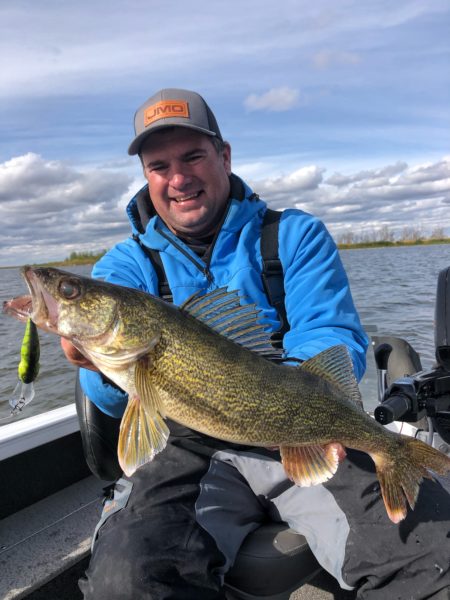A Case for Cranks on Natural Lakes
Category: article
Mar 24th, 2020 by Keith Worrall
Modified Mar 24th, 2020 at 9:37 AM
A Case for Cranks on Natural Lakes
By Jason Mitchell
Early season post spawn walleye tactics often incorporate live bait rigging and jigging. Particularly with states like Minnesota and Wisconsin that have a walleye opener, crankbaits often get overlooked on many fisheries and they shouldn’t. Many anglers associate presentations with water temperatures. Rigs and jigs, perhaps live bait early in the season with faster and more aggressive presentations kicking in when the water temperatures warm up. There are some elements to these general assumptions that do seem to hold true. What also determines the presentations however is the location.
If you are finding fish stacked up on one side of an offshore reef in twenty-five feet of water on a spot the size of half a tennis court, trolling crankbaits is going to be inefficient. Both rigging and jigging are excellent presentations for pinpoint location. Here are a few scenarios however where I absolutely clean up trolling with crankbaits on natural lakes early in the season. Large expansive sand and gravel flats that come off shorelines often hold a lot of fish. When these locations are big, say a football field or bigger, crankbaits allow you to find fish faster. We also find that these fish are often moving or scattered so crankbaits really shine because you can breakdown water. Now you can also snap jig these locations as well at a faster speed to find and catch fish. What I like about crankbaits however is I can control the running depth much better if there are emerging weeds starting to appear. If weeds are starting to grow in clumps that range between one to two feet off the bottom, I can run my cranks precisely at three feet off the bottom and feel I can cover distances more efficiently.

Don’t overlook crankbait trolling patterns on natural lakes early in the season. The author Jason Mitchell with a beautiful walleye caught slow trolling a Salmo Bullhead 8SDR.
My absolute favorite situation for trolling crankbaits early in the season is what I call a “hot wind.” The first warm days of late spring when the temperatures are bumping up and the wind starts to blow hard and feel warm. The surface water temps might jump four or more degrees in an afternoon and this warmer water is quickly getting mixed deeper into the water column. In these conditions, fish really seem to respond well to the vibration and speed of crankbaits.
Typically, when fish are relating to shoreline contours which they often do early in the season (especially if wind has been pounding into the locations), we get focused on the irregularities. We look for points or inside turns. Maybe a flat protrudes out or there are some tighter contour lines along an area where the break is much sharper. These irregularities are often where fish get concentrated and focused and if the spot is small, go back to rigging and jigging. Some shoreline contours however can be bland and uniform. This is another perfect scenario to troll crankbaits to cover water.
Many different crankbait styles and lures can work early in the season. Often, we find some of our most consistent crankbait patterns early in the season in less than twelve feet of water. Jerk baits or shallow running minnow profile lures often shine in clear water and cold water that is less than fifty-five degrees. This style of lure has the line tie on the front of the lure instead of the bill and these lures typically run shallow and take more line behind the boat. Classic options include the Rapala Husky Jerk or Smithwick Rattling Rogue. A lure today that I absolutely love and have a lot of confidence in is the Salmo Rattling Sting. We have filmed several episodes with the Sting and this lure just catches fish and runs perfect out of the box. This style of lure really shines when fish are shallow and spooking from the boat.
With less of a dive curve, these lures can be fished further back behind the boat. I often find that I catch more with these lures by snapping or pumping the rod. When you are using these suspending minnow style lures, pump the lure next to the boat and adjust the lure, snap and line so that the lure really hangs horizontal. I find that on tough bites especially, lures that just hang without sinking or tipping nose down seem to catch more fish. I believe this is why the Sting is so effective is the balance. Early in the season, this hang or pause can be important and often seems easier to accomplish at times by using straight up ten-pound mono. Later in the summer when the water warms up and I am dealing with more weeds, I often switch to braid with a heavier fluorocarbon leader because I find that I can snap the lure more aggressively and not stop the lure for such long periods of time. Again, these are just observations and general assumptions based on my own experiences.
The other lure category that shines are traditional crankbait style lures that have a deeper dive curve where the line attachment is on the bill. Classic lures in this category include the Rapala Shad Rap, Salmo Hornet and Berkley Flicker Shad. If there is one lure however that is my absolute favorite early in the season that doesn’t ever get talked about by many anglers, that lure would be a Salmo Bullhead 8SDR. This might be the best lure ever that most people have never heard of. I love to troll these lures over shallow sand flats in six to twelve feet of water that are getting baked by the sun. At times I will use planer boards if I can run multiple lines clean or if the fish are bumping from the boat.
Especially during calm conditions, I often troll crankbaits early in the season with the bow mount trolling motor and find that I catch a lot of fish by bumping down my speed to 1.4 to 1.6 miles per hour. In the wind or if the water temps are really climbing, I find that I can troll much faster and catch fish. I often put the lure in the water next to the boat and see how slow I can troll to get the vibration. Bow mount trolling motors that have speed control are deadly for trolling crankbaits early in the season because you can just crawl along. Over large flats, implement a lot of S curves so that the lures speed up and slow down so you can fine tune the speed even more. If all the fish come on the turn, speed up. If the fish start coming on the stall, slow down. Sometimes, just the change in speed is the trigger. By zigzagging this way, you also pull your baits in front of fish that are bumping off the boat which is common early in the season.
On so many natural lakes, live bait and classic jig and rig presentation are entrenched as they should be but don’t overlook the effectiveness of trolling cranks. This presentation allows you to cover water and you can really rack up fish fast when everything comes together. There are situations where trolling cranks might be the very best presentation for learning water and finding fish. There are other situations where trolling cranks can be the very best presentation for simply putting the hammer down on fish. The difference can be dramatic.
Jason Mitchell Outdoors airs on Fox Sports North on Sunday morning at 9:00 am and Midco on Sunday at Noon. More information and past episodes can be found online at www.jasonmitchelloutdoors.com.
